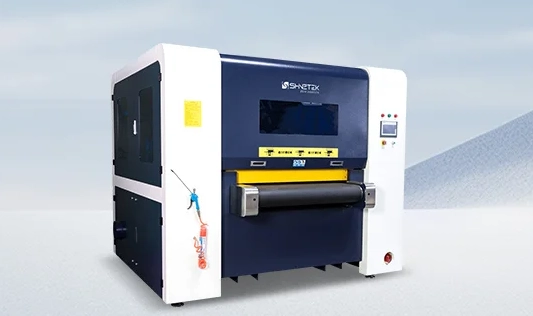In advanced manufacturing industries, achieving a flawless surface is more than a matter of appearance—it's a matter of functionality, compliance, and performance reliability. Metal parts used in aerospace, medical, defense, and automotive applications often require ultra-clean surfaces that are free from burrs, spatter, and thermal slag. These imperfections, typically left behind by plasma cutting, laser cutting, or welding, can compromise coating adhesion, cause mechanical stress concentration, and lead to premature product failure. This is where the deslagging machine becomes indispensable. Designed specifically to remove slag and thermal residues from metal surfaces, a deslagging machine operates with high precision to ensure consistent, repeatable, and burr-free results. It replaces labor-intensive manual grinding with an automated process that is safer, faster, and more reliable. In doing so, it prepares components for downstream operations like powder coating, anodizing, CNC machining, and assembly with exceptional consistency. Furthermore, the use of a deslagging machine enhances workplace safety and ergonomics. Manual methods expose operators to noise, flying debris, and vibration. In contrast, an enclosed and ventilated deslagging system significantly reduces exposure to occupational hazards while increasing process throughput. In short, the deslagging machine elevates surface quality from acceptable to optimal—providing a critical link between fabrication and finishing in any modern production line.

How a Deslagging Machine Works: Principles of Operation and Control
The operational effectiveness of a deslagging machine lies in its ability to remove hardened slag without altering the underlying material properties or compromising dimensional accuracy. At the core of this technology is a system of rotating brushes, abrasive belts, or hammer-like mechanisms configured to apply precise, uniform mechanical force across complex surfaces.
Most deslagging machines are equipped with stainless steel or ceramic-coated wire brushes that rotate in opposite directions to provide multi-directional surface treatment. These brushes make controlled contact with the metal surface, shearing off slag and residual oxides while leaving the parent material untouched. By adjusting brush stiffness, rotation speed, and vertical pressure, operators can fine-tune the machine to accommodate different material types—from carbon steel and stainless steel to aluminum and titanium alloys.
Some high-end deslagging machines integrate smart controls with programmable logic controllers (PLCs) or human-machine interfaces (HMIs). These allow operators to store recipes for different part geometries, automate feed speed, and monitor brush wear in real time. Such features are particularly useful in high-mix production environments where consistency across product variants is critical.
Additionally, dust extraction and filtration are integral to machine performance. Deslagging generates fine metal particles that, if not properly contained, can damage sensitive components, interfere with coatings, or create health hazards. Built-in vacuum systems, HEPA filters, and spark arrestors ensure a clean and safe operational environment.
By combining precision mechanics, adaptive control, and integrated safety systems, the deslagging machine delivers reliable and repeatable surface preparation that is essential for manufacturing excellence.
Integrating Deslagging Machine into Precision Manufacturing Workflows
In lean and digitally connected production environments, the deslagging machine is not a standalone unit—it's a fully integrated element of the production ecosystem. Its placement and synchronization within the manufacturing process have a direct impact on quality assurance, takt time, and end-product performance.
Typically, the deslagging machine is positioned immediately after thermal cutting stations and just before finishing processes such as deburring, edge rounding, or coating. This logical integration ensures that slag is removed before it can affect downstream tasks. By creating a clean, burr-free surface, the machine improves coating adhesion, prevents contamination during welding, and enhances dimensional accuracy in subsequent CNC machining operations.
Modern factories often connect deslagging machines to Manufacturing Execution Systems (MES) and Enterprise Resource Planning (ERP) software. This digital integration enables automated job tracking, predictive maintenance scheduling, and real-time performance monitoring. Operators can assign specific part profiles to the machine, and the system will adjust its parameters accordingly—minimizing downtime and optimizing batch consistency.
Moreover, robotic material handling systems can be synchronized with the deslagging machine for fully automated loading, alignment, and unloading. This reduces labor costs, eliminates human error, and supports 24/7 production schedules. In high-volume operations such as appliance fabrication, control panel manufacturing, and structural steel processing, these integrations provide a competitive edge.
Ultimately, incorporating a deslagging machine into the manufacturing workflow isn't just about slag removal—it's about enabling a more streamlined, digital, and error-resistant production process from raw sheet to final product.
In today's high-stakes manufacturing environment, perfection is not optional—it is required. And when it comes to preparing metal surfaces for critical downstream processes, the deslagging machine stands as a foundational technology. It offers a combination of precision, repeatability, and automation that manual methods cannot match. Whether you're operating in aerospace, automotive, medical, energy, or general sheet metal fabrication, integrating a deslagging machine enhances your ability to deliver defect-free products on time and on spec. It improves quality, supports compliance, protects tooling, and reduces costs—making it not just a helpful tool, but a strategic advantage. For manufacturers committed to continuous improvement, the message is clear: If you value surface integrity, efficiency, and quality, the deslagging machine deserves a permanent place on your production floor.
https://www.shinetekgrind.com/Products
www.shinetekgrind.com
Suzhou Shinetek Grinding Technology Co., Ltd.
